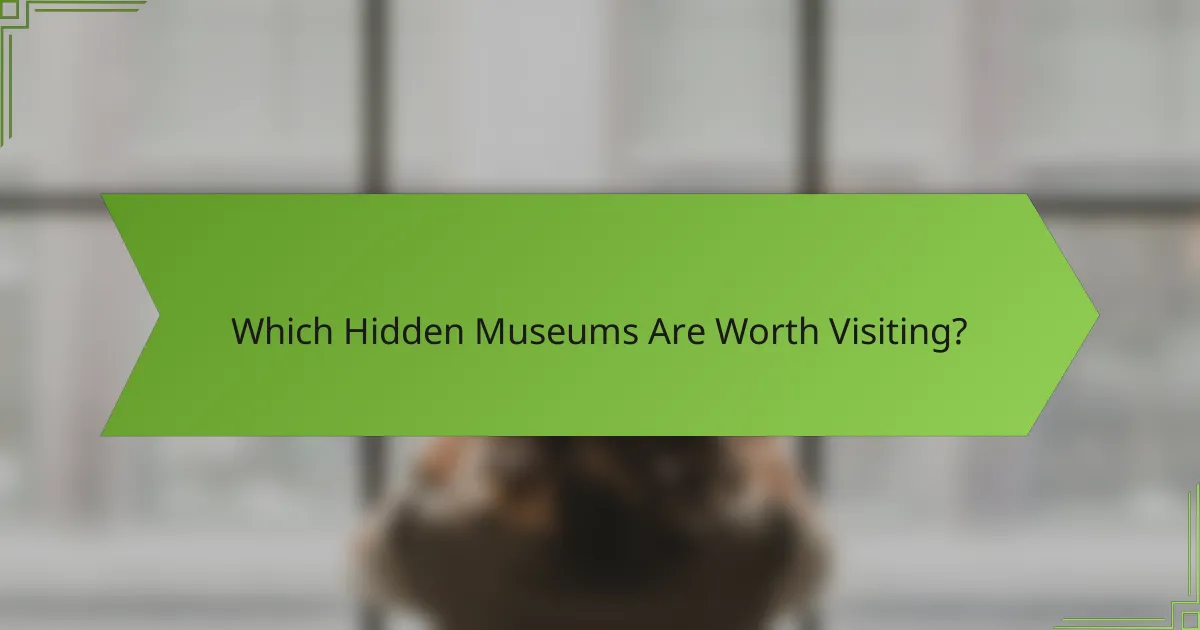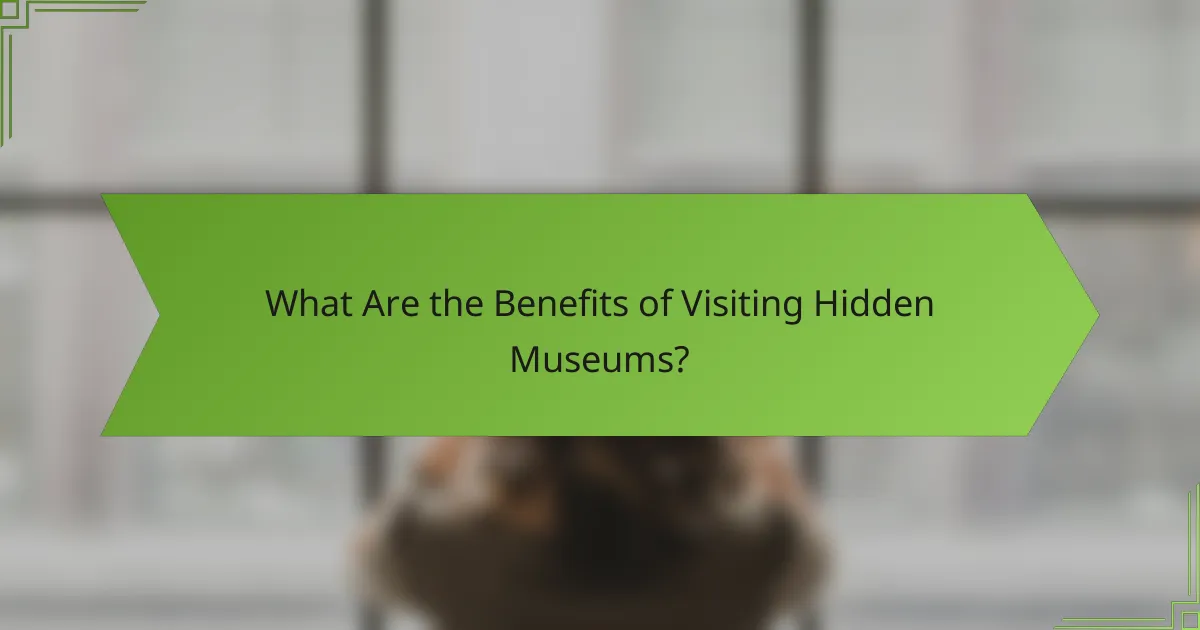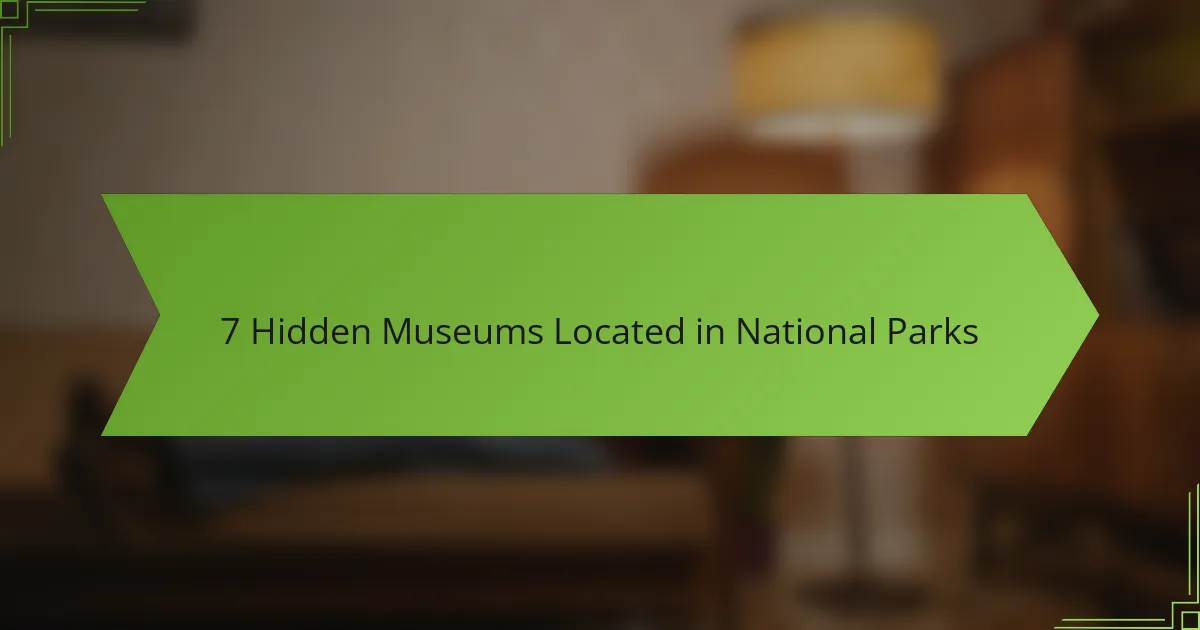Exploring hidden museums in remote locations can lead to unforgettable experiences that delve into niche topics and local culture. These unique institutions often feature specialized collections and interactive exhibits, offering insights that mainstream museums may overlook. Planning your visit with attention to logistics and accommodations will ensure a smooth journey to discover these hidden gems.

Which Hidden Museums Are Worth Visiting?
Several hidden museums across the globe offer unique experiences that make the journey worthwhile. These museums often focus on niche topics, providing insights and exhibits that are not found in mainstream institutions.
Museum of Jurassic Technology
Located in Los Angeles, California, the Museum of Jurassic Technology is a blend of art, science, and whimsy. It showcases a collection of exhibits that explore the intersection of history and imagination, often blurring the lines between fact and fiction.
Visitors can expect to see artifacts ranging from miniature sculptures to bizarre scientific curiosities. The museum encourages exploration and contemplation, making it a perfect stop for those interested in the unconventional.
International Cryptozoology Museum
The International Cryptozoology Museum in Portland, Maine, is dedicated to the study of hidden or unknown animals, often referred to as cryptids. This museum features exhibits on legendary creatures like Bigfoot and the Loch Ness Monster, alongside scientific discussions about the possibility of their existence.
With a focus on both folklore and science, the museum provides a unique perspective on how cultures interpret the unknown. Visitors can engage with interactive displays and learn about ongoing cryptozoological research.
The Museum of Bad Art
Situated in Somerville, Massachusetts, The Museum of Bad Art celebrates artwork that is considered to be poorly executed or unintentionally humorous. This quirky museum aims to highlight the beauty in imperfection and the joy of art in all its forms.
Exhibits feature a variety of pieces that evoke laughter and curiosity, making it a lighthearted destination. The museum encourages visitors to appreciate the creativity behind each work, regardless of its artistic merit.
The Neon Museum
Located in Las Vegas, Nevada, The Neon Museum is dedicated to preserving iconic Las Vegas signs and neon art. The museum features a collection of restored and unrestored signs that tell the story of the city’s vibrant history.
Visitors can explore the outdoor exhibition space known as the Neon Boneyard, where they can see signs from defunct casinos and businesses. Guided tours provide insights into the significance of each piece, making it a must-see for fans of retro culture.
Salem Witch Museum
The Salem Witch Museum in Salem, Massachusetts, offers a deep dive into the infamous witch trials of 1692. The museum presents the historical context of the trials through exhibits and dramatic presentations, shedding light on the societal fears that fueled the events.
Visitors can learn about the individuals involved and the impact of the trials on American history. The museum provides a reflective space for understanding the consequences of mass hysteria and injustice.

What Unique Experiences Do These Museums Offer?
These hidden museums provide unique experiences that go beyond traditional exhibits, often featuring interactive elements, specialized collections, and deep insights into local culture. Visitors can engage with the displays, discover rare artifacts, and learn about the history and traditions of the surrounding area.
Interactive exhibits
Many remote museums incorporate interactive exhibits that allow visitors to engage directly with the displays. This can include hands-on activities, digital interfaces, or immersive environments that enhance learning and enjoyment. For example, a museum in a coastal town might feature a touch tank where visitors can interact with marine life.
When visiting, look for opportunities to participate in workshops or guided tours that encourage interaction. These experiences often make the visit more memorable and informative, especially for families and younger audiences.
Specialized collections
Hidden museums often boast specialized collections that focus on niche topics or local history, making them unique destinations. For instance, a museum dedicated to a specific craft, such as pottery or weaving, may showcase techniques and tools that are not found in larger institutions. This focus can provide a deeper understanding of the cultural significance of these crafts.
Before visiting, research the museum’s collection to ensure it aligns with your interests. Some museums may also host rotating exhibits, so check for any special displays that might be available during your visit.
Local cultural insights
These museums frequently offer rich insights into the local culture, showcasing traditions, folklore, and historical events that shaped the community. Engaging with local artifacts and narratives can provide a more profound appreciation for the region’s heritage. For example, a museum in a rural area might highlight agricultural practices and their evolution over time.
To maximize your experience, consider participating in guided tours or community events that the museum may host. These activities often feature local experts who can share stories and context that enhance your understanding of the exhibits.

How to Plan Your Visit to Remote Museums?
Planning a visit to remote museums requires careful consideration of logistics, timing, and accommodations. Understanding transportation options, the best times to visit, and nearby lodging can enhance your experience and ensure a smooth journey.
Transportation options
Accessing remote museums often involves multiple transportation methods. Depending on the location, you may need to drive, take a bus, or even fly to the nearest airport followed by a rental car or shuttle service.
For example, if visiting a museum in a mountainous region, check for local bus services or car rentals that can navigate rugged terrain. Always verify the availability of public transport, as it may be limited in less populated areas.
Best times to visit
The ideal time to visit remote museums typically aligns with local weather patterns and tourist seasons. Spring and early fall are often recommended for pleasant weather and fewer crowds.
Consider checking local events or festivals that might coincide with your visit, as these can enhance your experience but may also lead to increased visitor numbers. Aim for weekdays if possible, as weekends can be busier.
Accommodations nearby
Finding suitable accommodations near remote museums can vary greatly based on location. Options may range from hotels and motels to bed-and-breakfasts or even camping sites, depending on the area’s amenities.
It’s advisable to book in advance, especially during peak tourist seasons. Websites that aggregate lodging options can help you compare prices and amenities, ensuring you find a place that meets your needs without overspending.

What Are the Benefits of Visiting Hidden Museums?
Visiting hidden museums offers a range of benefits, including a more intimate experience with art and culture, as well as the opportunity to discover unique exhibits that may not be found in larger institutions. These lesser-known venues often provide a deeper connection to local history and community.
Less crowded environments
Hidden museums typically attract fewer visitors, allowing for a more peaceful and personal experience. This means you can take your time exploring exhibits without feeling rushed or overwhelmed by crowds.
In less crowded settings, you can engage more deeply with the artwork and artifacts, often having the chance to ask questions or interact with knowledgeable staff. This personalized attention can enhance your understanding and appreciation of the exhibits.
Unique educational opportunities
Many hidden museums focus on niche topics or local history, providing unique educational experiences that larger museums may overlook. This can include specialized exhibits on regional art, culture, or science that offer insights into the local community.
Visitors often find that these museums host workshops, lectures, or guided tours that are tailored to specific interests. Engaging with these programs can enrich your knowledge and provide a more immersive learning experience.
Support for local communities
By visiting hidden museums, you contribute to the local economy and support community initiatives. Many of these institutions rely on ticket sales and donations to operate, so your visit directly impacts their sustainability.
Additionally, these museums often collaborate with local artists and historians, showcasing their work and preserving regional culture. Supporting hidden museums helps to foster a vibrant cultural scene that benefits everyone in the area.

What Criteria Should You Consider When Choosing a Museum?
When selecting a museum to visit, consider factors like accessibility, the relevance of exhibits, and visitor feedback. These criteria can significantly enhance your experience and ensure you make the most of your journey.
Location accessibility
Accessibility refers to how easy it is to reach a museum, especially if it’s in a remote area. Check the available transportation options, such as public transit, parking facilities, and the distance from major cities. For instance, a museum located a few hours from a major airport may require careful planning to ensure a smooth visit.
Consider the physical accessibility of the museum itself. Look for information on wheelchair access, guided tours, and amenities that cater to visitors with disabilities. A well-connected museum can make your visit more enjoyable and stress-free.
Exhibit relevance
Exhibit relevance pertains to how well the museum’s collections align with your interests. Research the types of exhibits offered, whether they focus on local history, art, science, or niche topics. A museum with specialized collections may provide a unique experience that resonates more with certain visitors.
Additionally, check for temporary exhibitions or events that might enhance your visit. Museums often rotate their displays, so staying informed about current offerings can help you choose a museum that aligns with your interests at the time of your visit.
Visitor reviews
Visitor reviews can provide valuable insights into the overall experience at a museum. Look for feedback on aspects such as exhibit quality, staff friendliness, and the overall atmosphere. Websites like TripAdvisor or Google Reviews can be helpful in gauging public opinion.
Pay attention to common themes in the reviews. If multiple visitors mention long wait times or poorly maintained facilities, it may be worth considering alternatives. Conversely, positive reviews highlighting engaging exhibits or knowledgeable staff can indicate a worthwhile visit.

What Are the Costs Associated with Visiting These Museums?
The costs of visiting hidden museums in remote locations can vary widely based on factors such as admission fees, travel expenses, and additional services. Understanding these costs helps in planning a budget-friendly trip while ensuring a fulfilling experience.
Admission fees
Admission fees for hidden museums typically range from free to around €15 or $20 per person. Some museums may offer discounted rates for students, seniors, or groups, while others might have special days with no entry fees.
It’s advisable to check the museum’s official website for the latest pricing and any available promotions. Some locations may also charge additional fees for special exhibitions or guided tours, which can enhance your visit.



